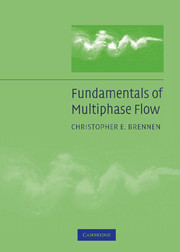Book contents
- Frontmatter
- Contents
- Preface
- Nomenclature
- 1 Introduction to Multiphase Flow
- 2 Single-Particle Motion
- 3 Bubble or Droplet Translation
- 4 Bubble Growth and Collapse
- 5 Cavitation
- 6 Boiling and Condensation
- 7 Flow Patterns
- 8 Internal Flow Energy Conversion
- 9 Homogeneous Flows
- 10 Flows with Bubble Dynamics
- 11 Flows with Gas Dynamics
- 12 Sprays
- 13 Granular Flows
- 14 Drift Flux Models
- 15 System Instabilities
- 16 Kinematic Waves
- Bibliography
- Index
10 - Flows with Bubble Dynamics
Published online by Cambridge University Press: 05 June 2014
- Frontmatter
- Contents
- Preface
- Nomenclature
- 1 Introduction to Multiphase Flow
- 2 Single-Particle Motion
- 3 Bubble or Droplet Translation
- 4 Bubble Growth and Collapse
- 5 Cavitation
- 6 Boiling and Condensation
- 7 Flow Patterns
- 8 Internal Flow Energy Conversion
- 9 Homogeneous Flows
- 10 Flows with Bubble Dynamics
- 11 Flows with Gas Dynamics
- 12 Sprays
- 13 Granular Flows
- 14 Drift Flux Models
- 15 System Instabilities
- 16 Kinematic Waves
- Bibliography
- Index
Summary
Introduction
In Chapter 9, the analyses were predicated on the existence of an effective barotropic relation for the homogeneous mixture. Indeed, the construction of the sonic speed in Sections 9.3.1 and 9.3.3 assumes that all the phases are in dynamic equilibrium at all times. For example, in the case of bubbles in liquids, it is assumed that the response of the bubbles to the change in pressure, δp, is an essentially instantaneous change in their volume. In practice this would be the case only if the typical frequencies experienced by the bubbles in the flow are very much smaller than the natural frequencies of the bubbles themselves (see Section 4.4.1). Under these circumstances the bubbles would behave quasistatically and the mixture would be barotropic. However, there are a number of important contexts in which the bubbles are not in equilibrium and in which the nonequilibrium effects have important consequences. One example is the response of a bubbly multiphase mixture to high-frequency excitation. Another is a bubbly cavitating flow where the nonequilibrium bubble dynamics lead to shock waves with substantial noise and damage potential.
In this chapter we therefore examine some flows in which the dynamics of the individual bubbles play an important role. These effects are included by incorporating the Rayleigh–Plesset equation (Rayleigh 1917, Knapp et al. 1970, Brennen 1995) into the global conservation equations for the multiphase flow. Consequently the mixture no longer behaves barotropically.
- Type
- Chapter
- Information
- Fundamentals of Multiphase Flow , pp. 199 - 216Publisher: Cambridge University PressPrint publication year: 2005

